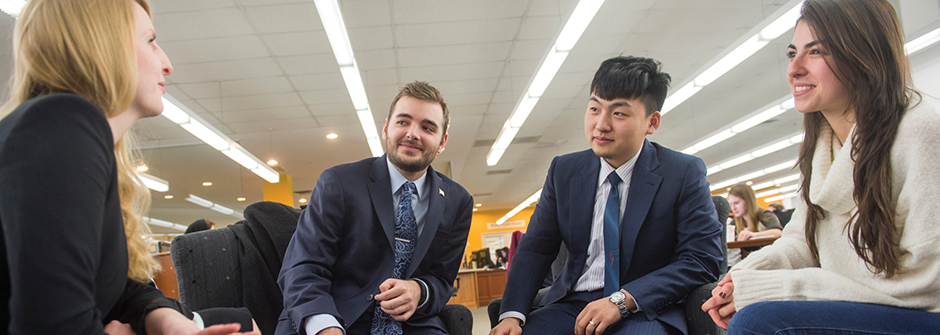
Curriculum
Customer Experience is multi-faceted and relies on the strong relationships you build with your customers. The Customer Experience Certificate Program meets the same high academic standards of the Seton Hall University Stillman School of Business graduate programs, with a challenging interdisciplinary curriculum designed to prepare CX professionals to excel in their field.
Roll up your sleeves to solve real-world challenges and use practices developed by top companies.
Module 1:
Customer Experience Introduction
Define the concept of Customer Experience. Find out what makes a beloved company and
the essential elements that endear these brands to us.
- Identify Customer Experience leaders and laggards.
- Discuss what sets these types of experiences apart from others, making you less likely to advocate for a certain brand.
- Create your comparison scorecard to identify critical elements that set leaders apart from the rest.
Module 2:
Customer Experience Strategy for Success
Learn why Customer Experience isn’t a project with a start and end date, and why this
isn’t a state of mind – it’s a state of your organization and it starts at the top.
Integrating Customer Experience into business strategy, and skillfully executing,
leads to enormous rewards. You’ll achieve higher customer engagement, reduced churn,
increased revenue, and greater employee satisfaction.
- Develop insights into what a customer-centric organization looks like and how to get there.
- Discover elements that comprise an effective and strategic customer experience plan.
- Create critical goals and roadmap to help reach your customer experience vision.
Module 3:
Your Customers, Their Journey
Customer Experience Journey Maps are arguably the most important instrument for capturing
your customer’s true interactions—emotionally and cognitively—with your company’s
brand. Evaluate your customers and their experiences, and use these strategic tools
for communications, analysis, planning, management, and innovation.
- Develop insightful customer personas and stories that promote cultural empathy and impact decisions.
- Identify critical customer views of interactions throughout multi-channel touchpoints.
- Use journey maps to capture experiences and emotions and help improve the lives of your customers.
Module 4:
Accelerate & Improve Decisions with Data
Customer Experience initiatives fizzle quickly if you don’t connect the dots between
your customers’ perceptions, touch points, service delivery, cost savings and ROI.
Customer churn rates, share of wallet, Net Promoter Scores, average handling times,
and cost of acquisition can and need to tie to your bottom line.
- Explore leading practices that drive ongoing business improvements.
- Link customer perceptions with operational costs and profitability.
- Discover the most relevant, actionable metrics for your organization to drive desired business results.
Module 5:
Customer-Focused Innovation
Customer-Focused Innovation is the perfect blend of theory, practice, strategy and
invention. Innovating on behalf of your customers doesn’t start with a problem statement
– it starts with your customer. Learn to use empathy techniques to break through the
culture barrier at your company and close the “knowing-doing” gap.
- Apply creative strategies that support innovation.
- Gain insights to understand the needs of your customers.
- Work to improve customer experience while adding value they'll rave about.
Module 6:
Principles of Customer Relationship Building
Customer Experience is multi-faceted and relies on the strong relationships you build
with your customers. Use the Customer Relationship Development Model to identify and
define core elements to build relationships and improve overall experiences. Through
collaboration and ideation, you create a maturity matrix specifically for your business.
- Apply modern ideation and relationship building models.
- Develop your own Customer Experience-based Customer Relationship Maturity Matrix.
- Discover essential elements and apply the Technology Framework for CRM and Customer Experience.
Module 7:
Customer First Culture
Today, the customer is almighty. Now is the time to educate yourself and your workforce
to create a customer-first culture that positions you for the greatest, longest-term
success. This isn’t “blowing up” the culture you already have – it’s embracing what
you have and acting together to make a difference in how your brand is perceived.
Enjoy this creative session to deconstruct cutting-edge cultures and set the vision
and goals for your own.
- Accept the reality that your customer experience will never exceed your employee experience.
- Engage the hearts and minds of your people.
- Define how to work together to deliver your brand promise and great customer experiences.
Module 8:
Navigating Politics of Change
Change is hard, people are resistant, and the market is becoming more fiercely competitive
every day. Organizations must quickly evolve or be left behind. It takes a special
leader to navigate these waters and get your entire organization marching to the same
drummer. Arm yourself with these indispensable leadership skills.
- Discover how to drive adoption across your entire organization.
- Successfully jumpstart your role by gaining quick wins and bring others along with you.
- Become a successful change-agent for experience-first thinking and inspire change.
Capstone Project The Customer Experience Portfolio
During the program, you’ll work on your Capstone Project to apply your learnings toward a real or hypothetical real-world problem that you will solve during the eight-module program. By the end of the class, you will have completed your very own Professional Customer Experience Portfolio.
Your MBA Is Within Reach with Your Certificate from Seton Hall's Stillman School of Business
Your Seton Hall Customer Experience Certificate provides the differentiating factor. It proves that you have completed all modules, as well as the cumulative Capstone Project. You’ll walk away with confidence and your own, professional Customer Experience Portfolio. You’ll receive two graduate management elective credits. If you apply and are accepted to the MBA program, you will receive a third credit when you complete a project with Seton Hall faculty.
